
Nottingham is a city and unitary authority area in Nottinghamshire, East Midlands, England. It is located 110 miles (180 km) north-west of London, 33 miles (53 km) south-east of Sheffield and 45 miles (72 km) north-east of Birmingham. Nottingham is the legendary home of Robin Hood and to the lace-making, bicycle and tobacco industries. The city is also the county town of Nottinghamshire and the settlement was granted its city charter in 1897, as part of Queen Victoria's Diamond Jubilee celebrations.

Blois is a commune and the capital city of Loir-et-Cher department, in Centre-Val de Loire, France, on the banks of the lower Loire river between Orléans and Tours.

A Rube Goldberg machine, named after American cartoonist Rube Goldberg, is a chain reaction–type machine or contraption intentionally designed to perform a simple task in an indirect and (impractically) overly complicated way. Usually, these machines consist of a series of simple unrelated devices; the action of each triggers the initiation of the next, eventually resulting in achieving a stated goal.

Badīʿ az-Zaman Abu l-ʿIzz ibn Ismāʿīl ibn ar-Razāz al-Jazarī was a Muslim polymath: a scholar, inventor, mechanical engineer, artisan, artist and mathematician from the Artuqid Dynasty of Jazira in Mesopotamia. He is best known for writing The Book of Knowledge of Ingenious Mechanical Devices in 1206, where he described 50 mechanical devices, along with instructions on how to construct them. He is credited with the invention of the elephant clock. He has been described as the "father of robotics" and modern day engineering.

Nottingham Trent University (NTU) is a public research university in Nottingham, England. Its roots go back to 1843 with the establishment of the Nottingham Government School of Design, which still exists within the university today. It is the sixth largest university in the UK with 35,785 students split over five different campuses in Nottingham. The university has most recently opened a new campus in London.

Frederick Rowland Emett OBE, known as Rowland Emett, was an English cartoonist and constructor of whimsical kinetic sculpture.
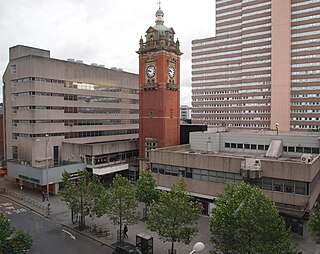
Victoria Centre is a shopping centre in Nottingham, England, constructed between 1967 and 1972. It contains fashion and high street chain stores as well as cafes, restaurants, a health and fitness centre, and the Nottingham Victoria bus station.
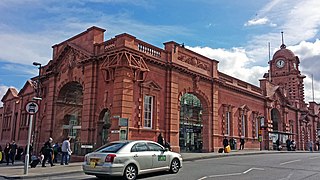
Nottingham station, briefly known as Nottingham City and for rather longer as Nottingham Midland, is a railway station and tram stop in the city of Nottingham. It is the principal railway station of Nottingham. It is also a nodal point on the city's tram system, with a tram stop that was originally called Station Street but is now known as Nottingham Station. It is the busiest station in Nottinghamshire, the busiest in the East Midlands, and the second busiest in the Midlands after Birmingham New Street.

The Queen Victoria Building is a heritage-listed late-nineteenth-century building located at 429–481 George Street in the Sydney central business district, in the state of New South Wales, Australia. Designed by the architect George McRae, the Romanesque Revival building was constructed between 1893 and 1898 and is 30 metres (98 ft) wide by 190 metres (620 ft) long. The domes were built by Ritchie Brothers, a steel and metal company that also built trains, trams and farm equipment. The building fills a city block bounded by George, Market, York, and Druitt Streets. Designed as a marketplace, it was used for a variety of other purposes, underwent remodelling, and suffered decay until its restoration and return to its original use in the late twentieth century. The property is co-owned by the City of Sydney and Link REIT, and was added to the New South Wales State Heritage Register on 5 March 2010.

Kitchener City Hall is the seat of municipal government of Kitchener, Ontario, Canada. It has gone through many iterations through the 20th century, culminating in the current building, which opened in 1993.
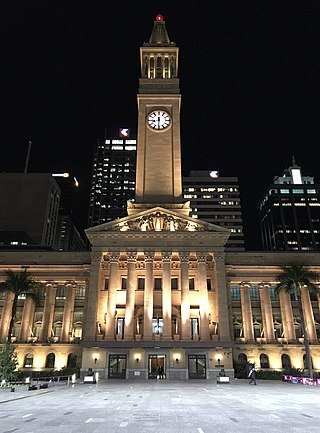
Brisbane City Hall, in Brisbane, Queensland, Australia, is the seat of the Brisbane City Council. It is located adjacent to King George Square, where the rectangular City Hall has its main entrance. The City Hall also has frontages and entrances in both Ann Street and Adelaide Street. The building design is based on a combination of the Roman Pantheon, and St Mark's Campanile in Venice and is considered one of Brisbane's finest buildings. It was listed on the Register of the National Estate in 1978 and on the Queensland Heritage Register in 1992. It is also iconic for its Westminster chimes which sound on the quarter-hour.

Piccadilly Gardens is a green space in Manchester city centre, England, on the edge of the Northern Quarter.

Nottingham College is one of the largest further education and higher education colleges in the United Kingdom. Based in the city of Nottingham in England, it provides education and training from pre-entry through to university-degree level at its 10 centres in the city and around Nottinghamshire.
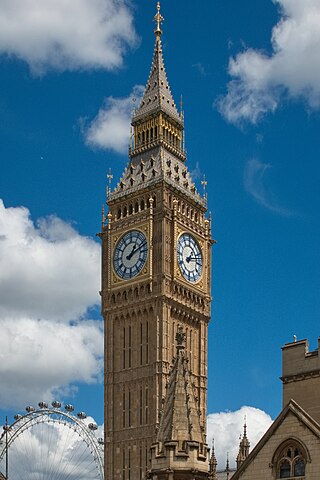
Big Ben is the common name for the Great Bell of the Great Clock of Westminster, and by extension to the clock tower and the clock itself. The Great Clock of Westminster is a striking clock with five bells. The clock tower is at the north end of the Palace of Westminster in London, England, and was originally known simply as the Clock Tower, but was renamed Elizabeth Tower in 2012 to mark the Diamond Jubilee of Elizabeth II.

Horsham is a market town on the upper reaches of the River Arun on the fringe of the Weald in West Sussex, England. The town is 31 miles (50 km) south south-west of London, 18.5 miles (30 km) north-west of Brighton and 26 miles (42 km) north-east of the county town of Chichester. Nearby towns include Crawley to the north-east and Haywards Heath and Burgess Hill to the south-east. It is the administrative centre of the Horsham district.

Craig-y-nos Castle, is a Scots baronial-style country house near Glyntawe in Powys, Wales. Built on parkland beside the River Tawe in the upper Swansea Valley, it is located on the southeastern edge of the Black Mountain. The castle, formerly owned by opera singer Adelina Patti, is now a hotel. Its landscaped grounds are now a country park, managed by the Brecon Beacons National Park Authority. They are listed on the Cadw/ICOMOS Register of Parks and Gardens of Special Historic Interest in Wales. The castle is a Grade II* listed building and its theatre has a separate Grade I listing.
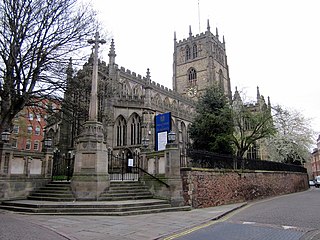
The Church of St Mary the Virgin is the oldest parish church of Nottingham, in Nottinghamshire, England. The church is Grade I listed by the Department for Digital, Culture, Media and Sport as a building of outstanding architectural or historic interest. It is one of only five Grade I listed buildings in the City of Nottingham.

The New Town Hall has stood on the Domshof in the centre of Bremen, Germany since 1913. Located behind the Unser-Lieben-Frauen-Kirchhof cemetery, it is adjacent to the older section of the Town Hall with which it forms a harmonious ensemble. Among its sumptuous rooms decorated with local artefacts, the New Town Hall houses the Senate Chamber used by the Senate for its regular meetings and the Great Hall, a venue for official receptions. In 2004, Bremen Town Hall was listed as a UNESCO World Heritage Site, together with the Roland of Bremen, because of its outstanding architecture and testimony to the development of civic autonomy during the Holy Roman Empire.

Eastham Country Park is a country park located in Eastham, Wirral. The park is situated next to the River Mersey and covers an area of 100 acres (40 ha). Facilities at the park include a visitor information centre, tea garden and picnic areas. There are two jetties that were formerly used to ferry people and goods from Wirral to Liverpool with the road leading to the park called 'Ferry Road.'
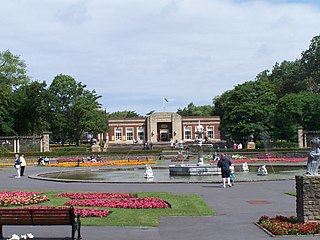
Stanley Park is a public park in the town of Blackpool on the Fylde coast in Lancashire, England. It is the town's primary park and covers an area of approximately 104 hectares. The park was designed to include significant sporting provisions, along with formal gardens, a boating lake and woodland area. It was designed and built in the 1920s, under the eye of Thomas Mawson.




















